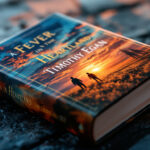The Boy From Block 66: A Powerful Book Review of Limor Regev’s Narrative
“The Boy From Block 66” by Limor Regev tells the poignant story of Moshe Kessler, a Jewish boy who survived the Holocaust. This gripping narrative sheds light on his harrowing experiences in concentration camps like Auschwitz and Buchenwald. Through Moshe’s eyes, readers witness the unimaginable brutality of the Nazi regime and the resilience of children caught in such darkness.
Regev captures not just the horrors of the camps but also the courage displayed by individuals, especially Antonin Kalina, often referred to as the “Czech Schindler.” He saved hundreds of children from certain death, showing that compassion can exist even in the direst of situations.
This book isn’t just a historical account; it’s a powerful reminder of the human spirit’s ability to endure. For anyone interested in understanding the impact of the Holocaust or looking for compelling stories of survival, “The Boy From Block 66” is essential reading. So, are you ready to uncover a tale that resonates with both heartbreak and hope?
Overview of The Boy From Block 66
“The Boy From Block 66” recounts the life story of Moshe Kessler, illuminating his journey from a thriving childhood to surviving the unimaginable horrors of the Holocaust. This section explores the profound experiences that shaped him, providing a deeper understanding of the triumph of the human spirit.
Moshe Kessler’s Early Life
Moshe Kessler was born in Berehove in 1930 into a close-knit Jewish community. Family played a central role in his upbringing; he shared a strong bond with his parents and younger brother. They experienced a simple yet joyful existence, blended with traditions that defined their cultural identity. Moshe’s early life was marked by laughter, friends, and the security that comes from belonging to a loving family.
However, this peace was shattered as the Nazi regime tightened its grip on Europe. The dark clouds of war began to loom over his community. At just 13 years old, Moshe was separated from his family during a transport to Auschwitz, marking the start of his harrowing journey. For more on his early experiences, check out this discussion with Moshe Kessler, where he shares details about his life before the war here.
Experiences in Concentration Camps
Upon arrival at Auschwitz, the brutality of the camp transformed Moshe’s life forever. He faced unimaginable horrors, witnessing atrocities that would haunt him for years. The heartlessness and inhumanity of the Nazis were starkly evident. Moshe’s resourcefulness became vital for survival; whether it was through sheer luck or quick thinking, he managed to evade some of the direst situations.
His journey didn’t end in Auschwitz. Moshe was later transferred to Buchenwald, where the conditions were equally grim. Each day was a fight for survival, as he navigated extreme hardships and the constant threat of death. The strength of his spirit was tested, but he found solace in thoughts of his family and the hope of freedom. To learn more about Kessler’s experiences in these camps, explore this link about his time at Auschwitz and Buchenwald here.
Post-War Challenges
After liberation, Moshe faced a new set of challenges. The world had changed, and so had he. The emotional and psychological scars from his time in the camps ran deep, making reintegration into normal life incredibly tough. He struggled to make sense of the loss—his family, friends, and the life he once knew were gone.
Rebuilding his life required immense resilience. He tried to reconnect with a sense of normalcy and began to forge new relationships. However, the haunting memories accompanied him, a reminder of both his suffering and survival. The journey was far from easy, but Moshe’s determination to honor his past and share his story became a driving force in his new life. For additional insights into his post-war experiences, read more about Kessler’s challenges here.
“The Boy From Block 66” captures not just the painful moments of Moshe’s life but also his remarkable journey of healing and hope. Through his story, readers are invited to reflect on the resilience of the human spirit when faced with unimaginable hardship.
Key Themes and Messages
“The Boy From Block 66” is not just a recounting of historical events. It serves as a powerful exploration of key themes like survival, resilience, and the importance of memory. These elements work together to portray a message that resonates with readers long after they finish the book.
Survival and Resilience
At the heart of Moshe Kessler’s story is the theme of survival amidst harrowing conditions. Kessler’s experiences in concentration camps highlight the remarkable ability of the human spirit to endure.
During his time in Auschwitz, Moshe faces unspeakable horrors. Yet, he finds ways to manage his fears and adapt to an environment filled with cruelty. His ability to think on his feet becomes a crucial part of his fight for survival. This theme emphasizes not just survival in a physical sense but also the emotional and mental resilience required to withstand such trauma.
Resilience is manifested through various acts, whether it’s sharing food with fellow prisoners or holding onto memories of happier times. These moments reveal a deeper truth: even when stripped of humanity, hope can shine through acts of kindness. It prompts us to consider, what drives someone to resist despair when everything seems lost? The tenacity shown by Kessler and others invites readers to reflect on their own reserves of strength in tough times.
For a more in-depth look at the powerful themes of survival and resilience in this book, check out this book summary.
The Importance of Memory
Another significant theme in “The Boy From Block 66” is the importance of memory. Moshe’s journey underscores the necessity of remembering history to ensure it is not repeated. The act of remembering serves as a form of resistance against the forces that seek to erase it.
Throughout his narrative, Kessler often revisits memories of his family, friends, and community. These recollections provide him with comfort amid chaos. They remind readers of the power of memory to shape identity and maintain connection, even in the darkest of circumstances. The book asserts that remembering is not just about preserving the past but learning from it. How can we hope to build a better future if we forget the lessons learned from our history?
Kessler’s commitment to sharing his experiences speaks volumes about the role of memory in healing. It prompts us all to acknowledge our past and honor the experiences that shaped us. To explore more about how memory plays a vital role in “The Boy From Block 66,” read more here.
This dual focus on survival and the significance of memory makes Limor Regev’s tale not only gripping but also a vital reminder. It urges readers to reflect on their own lives and the legacies we choose to uphold.
Writing Style and Emotional Impact
In “The Boy From Block 66,” Limor Regev employs a distinct writing style that significantly influences the emotional weight of the narrative. Through her choice of words and storytelling methods, she crafts a compelling account that resonates deeply with readers.
Narrative Techniques
Regev’s language is both powerful and evocative, effortlessly drawing readers into Moshe Kessler’s world. She utilizes vivid imagery and descriptive passages that evoke the sights, sounds, and emotions of the Holocaust experience. This immersion not only engages the reader’s senses but also creates a sense of urgency and immediacy.
One of the standout techniques in Regev’s writing is her ability to juxtapose moments of horror with instances of humanity. For instance, while depicting the cruelty of concentration camp life, she often shifts to poignant reflections on family and hope. This balance adds depth to the narrative, allowing readers to feel the weight of despair alongside flickers of resilience. Her style encourages readers to consider the small acts of kindness that persist even in the darkest times.
Additionally, the use of first-person perspective allows for an intimate connection with Moshe’s character. Readers aren’t just distant witnesses; they walk alongside him, feeling his pain and fear. This technique fosters a strong emotional response, as readers become invested in his journey.
For a deeper look at Regev’s writing style, check out this book review.
Emotional Reactions from Readers
Reader reactions to “The Boy From Block 66” are overwhelmingly emotional. Many describe the experience of reading the book as heart-wrenching, often leaving them in tears. Specific moments have struck chords with audiences from all backgrounds, demonstrating the universal themes of love, loss, and survival.
For example, scenes that depict the separation from Moshe’s family resonate deeply with readers. The pain of loss and longing is palpable, making it impossible for many not to reflect on their own experiences of love and grief. As one reader put it, “This was truly heartbreaking and made me realize how incredibly lucky I am,” revealing how personal connections to such historical narratives lead to profound contemplation.
Moreover, readers often express appreciation for the balance of despair and hope throughout Moshe’s story. As they witness his journey, they are reminded of the indomitable human spirit. This emotional rollercoaster keeps them engaged, prompting questions like: How does one maintain hope amid such darkness? Can acts of kindness truly shine through despair?
To see more reactions and reviews from readers, visit this summary of “The Boy From Block 66”.
The emotional depth of “The Boy From Block 66” doesn’t just tell a story; it invites readers to confront their feelings and reflect on what resilience means in the face of overwhelming adversity.
Reader Recommendations
When it comes to “The Boy From Block 66” by Limor Regev, this book has much to offer a variety of readers. Each group can find something valuable within its pages, whether they are looking for historical insight, emotional depth, or inspiring stories of resilience.
Who Should Read This Book?
Students: This book serves as an essential resource for students learning about the Holocaust and the impact of World War II. It provides a personal touch to historical events, helping students connect emotionally with the past. The themes of survival and resilience can spark rich discussions in classrooms.
Educators: Teachers will find “The Boy From Block 66” an effective tool in their curriculum. Its narrative can help facilitate lessons about history, ethics, and human rights. The story of Moshe Kessler can guide students in understanding difficult subjects through a lens of empathy and hope.
General Readers: Anyone passionate about stories of survival and human resilience will deeply appreciate this book. It is especially suited for readers who enjoy memoirs that recount real-life experiences. You don’t need to be an expert in history to find value in Moshe’s journey. His story transcends time and speaks to anyone who believes in the strength of the human spirit.
Ultimately, the book is for anyone who enjoys compelling narratives that tug at the heartstrings. The lessons learned can resonate with readers from all walks of life.
For more insights about who might benefit from reading, check out this reader discussion. For purchasing options, visit Amazon. It’s a story that you won’t want to miss.
Conclusion
“The Boy From Block 66” by Limor Regev stands as a poignant testament to the strength of the human spirit amid unimaginable suffering. Through Moshe Kessler’s experiences, readers not only grasp the horrors of the Holocaust but also witness acts of bravery and kindness that spark hope. The book is essential for anyone seeking to understand the past while also reflecting on themes of memory and resilience.
Consider picking up this book to enrich your perspective on history and human endurance. It serves as a crucial reminder that even in darkness, light can be found through shared stories and compassion. What lessons do you think we can carry forward from Moshe’s journey as we look to the future?







